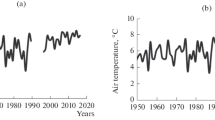Abstract
Long-term variations in the water balance were analyzed in the basins of 20 largest tributaries of the Baikal. The values of river runoff were derived from actual data on the period from 1976 to 2019, and those of evaporation, precipitation, and potential evaporation, from ERA5-Land reanalysis since 1976 to 2020. Data were obtained to show an increase in the potential evaporation in all analyzed drainage basins by values from 0.39 to 0.62% per year since 1976 to 2020. A moderate or statistically insignificant decrease is typical of precipitation (0.25 to 0.59% per year) and water discharges, mostly due to a decrease in the summer runoff at a rate of 5.6%/10 years. The possible role of changes in vegetation cover in these processes was studied by evaluating NDVI parameter in 2019 compared with 2002 by data of space surveys MOD13A3 and MYD13A3 with MODIS spectroradiometer of Terra and Aqua satellites. A conclusion was made about the key role of precipitation in the decrease in the maximal runoff in Lake Baikal basin.



Similar content being viewed by others
REFERENCES
Avtomatizirovannaya informatsionnaya sistema gosudarstvennogo monitoringa vodnykh ob’’ektov (AIS GMVO) (Automated Information System for State Monitoring of Water Bodies). //https://gmvo.skniivh.ru.
Ayurzhanaev, A.A., Andreev, S.G., Alymbaeva, Zh.B., Sodnomov, B.V., and Garmaev, E.Zh., Nekotorye aspekty prostranstvenno-vremennykh variatsii NDVI v Baikal’skom regione (Some Aspects of Space and Time Variations in NDVI in Baikal Region), Izd. Buryat. Gos. Univ., 2018, pp. 197–200.
Bibaeva, A.Yu., Forecast of geosystem transformation in the Northern Ol’khon Region, Usp. Sovrem. Estestvozn., 2018, no. 7, pp. 90–94.
Grigor’ev, V.Yu., Millionshchikova, T.D., Sazonov, A.A., and Chalov, S.R., Effect of changes in climate characteristics on river runoff in Baikal basin in the late XX–early XXI century, Vestn. Mosk. Univ., Ser. 5, Geography, 2020, no. 5, pp. 3–11.
Grigor’ev, V.Yu., Kharlamov, M.A., Semenova, N.K., et al., Changes in the flood runoff in rivers of the Baikal basin in 1979–2018, Tr. IX Mezhdunarod. nauch.-prakt. konf. “Morskie issledovaniya i obrazovanie (MARESEDU-2020)” (Proc. IX Intern. Sci.-Pract. Conf. Marine Studies and Education (MARESEDU-2020), Moscow, 2020, pp. 40–43.
Gunin, P.D., Miklyaeva, I.M., Bazha, S.N., Slemnev, N.N., and Cherdonova, V.A., Features of degradation and desertification of plant communities in forest-steppe and steppe ecosystems in the Southern Transbaikalia, Arid. Ekosist., 2003, vol. 9, pp. 19–20.
Dobrovol’skii, S.G., Year-to-year and many-year river runoff variations in Baikal drainage basin, Water Resour., 2017, vol. 44, no. 3, pp. 347–358.
Moreido, V.M. and Kalugin, A.S., Assessing possible changes in Selenga R. water regime in the XXI century based on a runoff formation model, Water Resour., 2017, vol. 44, no. 3, pp. 390–398.
Sinyukovich, V.N. and Chernyshov, M.S., Transformation of estimated characteristics of the annual and maximal runoff in the major tributaries of Lake Baikal, Water Resour., 2017, vol. 44, no. 3, pp. 372–379.
Sofronov, M.A., Antropov, V.F., and Volokitina, A.V., Pyrological characteristic of vegetation in Lake Baikal basin, Geogr. Prir. Res., 1999, no. 2, pp. 1–7.
Frolova, N.L., Zotov, L.V., Belyakova, P.A., Grigor’ev, V.Yu., and Sazonov, A.A., Many-year variations of river runoff in the Selenga Basin, Water Resour., 2017, vol. 44, no. 3, pp. 359–371.
Frolova, N.L., Magritskii, D.V., Kireeva, M.B., Grigor’ev, V.Yu., Gel’fan, A.N., Sazonov, A.A., and Shevchenko, A.I., Streamflow of Russian rivers under current and forecasted climate changes: a review of publications. 1. Assessment of changes in the water regime of Russian rivers by observation data, Water Resour., 2022, vol. 49, no. 3, pp. 333–350.
Aminjafari, S., Brown, I., Chalov, S., Simard, M., Lane Charles, R., Jarsjö, J., Darvishi, M., and Jaramillo, F., Drivers and extent of surface water occurrence in the Selenga River delta, Russia, J. Hydrol.: Regional Studies, 2021, vol. 38, p. 100945.
Antokhina, O.Y., Latysheva, I.V., and Mordvinov, V.I., A case study of Mongolian cyclogenesis during the July 2018 blocking events, Geogr. Environ. Sustain., 2019, vol. 12, no. 3, pp. 66–78.
Dorjsuren, B. et al., Observed trends of climate and land cover changes in Lake Baikal basin, Environ. Earth Sci., 2018, vol. 77, no. 20, pp. 1–12.
Karthe, D., Chalov, S., and Borchardt, D., Water resources and their management in central Asia in the early twenty first century: status, challenges, and future prospects, Environ. Earth Sci., 2014, vol. 73, no. 2, pp. 487–499.
Nasonova, O.N., Gusev, Y.M., and Kovalev, E., Climate change impact on water balance components in Arctic river basins, Geogr. Environ. Sustain., 2022, vol. 15, no. 4, pp. 148–157.
Sabater, J.M., ERA5-Land monthly averaged data from 1950 to present (Copernicus Climate Change Service [C3S] Climate Data Store [CDS]). https://cds.climate.copernicus.eu/cdsapp#!/dataset/reanalysis-era5-land-monthly-means?tab=overview
Safronov, A.N., Effects of climatic warming and wildfires on recent vegetation changes in the Lake Baikal basin, Climate, 2020, vol. 8, no. 4, p. 57.
U.S. Geological Survey // https://earthexplorer.usgs.gov.
Wang, G., Wang, P., Wang, T.Y., Zhang, Y.C., Yu, J.J., Ma, N., Frolova, N.L., and Liu, C.M., Contrasting changes in vegetation growth due to different climate forcings over the last three decades in the Selenga-Baikal basin, Remote Sens., 2019, vol. 11, no. 4. pp. 426.
Zorigt, M., Battulga, G., Sarantuya, G., Kenner, S., Soninkhishig, N., and Hauck, M., Runoff dynamics of the upper Selenga basin, a major water source for Lake Baikal, under a warming climate, Regional Environ. Change, 2019, vol. 19, no. 8, pp. 2609–2619.
Funding
The study was carried out under the Development Program of Interdisciplinary Scientific-Educational School at the Moscow State University “The Future of the Planet and Global Environmental Changes,” according to Research Plans (Governmental Order) of the N.I. Makkaveev Research Laboratory of Soil Erosion and Channel Processes, Faculty of Geography, Moscow State University, project 121051200166-4.
Author information
Authors and Affiliations
Corresponding authors
Additional information
Publisher’s Note.
Pleiades Publishing remains neutral with regard to jurisdictional claims in published maps and institutional affiliations.
Rights and permissions
About this article
Cite this article
Chalov, S.R., Denisova, I.S. & Grigor’ev, V.Y. Changes in Water Balance Elements in the Basins of the Largest Tributaries of Lake Baikal in the Late XX–Early XXI Century. Water Resour 50, 779–786 (2023). https://doi.org/10.1134/S0097807823700185
Received:
Revised:
Accepted:
Published:
Issue Date:
DOI: https://doi.org/10.1134/S0097807823700185




